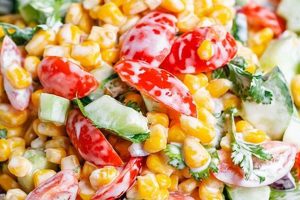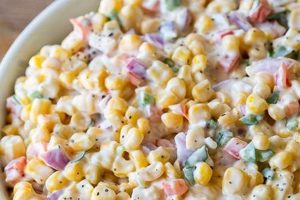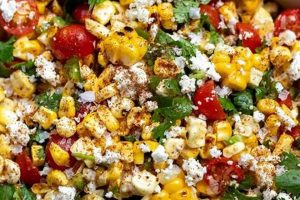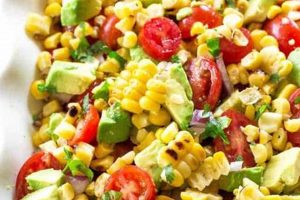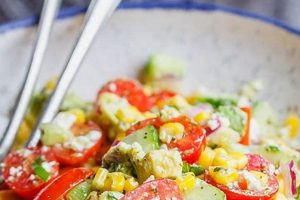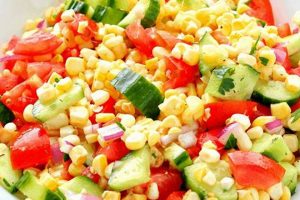A refreshing and versatile dish, typically composed of chilled sweet corn kernels combined with other complementary ingredients. Variations may include raw or cooked vegetables like bell peppers, onions, and tomatoes, along with herbs, spices, and a vinaigrette-style dressing. A simple example includes corn, red onion, cilantro, lime juice, and olive oil.
Such dishes offer a light and flavorful option, ideal for warm weather or as a side dish to grilled meats or fish. The nutritional value is significant, offering a good source of fiber, vitamins, and antioxidants. Historically, similar preparations have roots in various cultures’ cuisines, utilizing fresh, seasonal produce. The modern interpretations often reflect regional preferences and ingredient availability.
This exploration will further delve into variations, ingredient selection, preparation techniques, and serving suggestions for this popular dish. Detailed instructions, tips for achieving optimal flavor, and suggestions for customization will be provided.
Tips for a Perfect Corn Salad
Achieving optimal flavor and texture requires attention to detail. The following tips ensure a successful outcome.
Tip 1: Corn Selection: Freshly picked sweet corn, when in season, yields the best flavor. Frozen kernels can be substituted, but ensure they are thawed and drained thoroughly.
Tip 2: Balancing Flavors: Consider a mix of sweet, savory, acidic, and spicy elements. Bell peppers offer sweetness, red onion provides sharpness, while jalapeo adds heat. Herbs like cilantro or parsley contribute freshness.
Tip 3: Dressing Consistency: The vinaigrette should be light and flavorful, not overly heavy. A balance of oil and acid is crucial. Experiment with different vinegars, such as red wine vinegar, apple cider vinegar, or lime juice.
Tip 4: Chilling Time: Allowing the salad to chill for at least 30 minutes enhances the flavors and allows them to meld. Avoid chilling for extended periods, as this can make the vegetables soggy.
Tip 5: Ingredient Ratios: Adjust the quantities of ingredients to preference. Some may prefer more corn, while others might prefer a greater proportion of vegetables.
Tip 6: Texture Variation: Incorporating ingredients with different textures adds complexity. Consider adding diced avocado for creaminess, or toasted pepitas for crunch.
Tip 7: Serving Suggestions: This versatile dish can be served as a light lunch, a side dish to grilled meats or fish, or as part of a larger buffet spread.
By following these guidelines, one can create a vibrant and flavorful salad that showcases the sweetness of corn and the complementary flavors of other fresh ingredients.
This comprehensive overview provides the foundation for creating numerous variations, adapting recipes to individual tastes and preferences.
1. Fresh Corn
Fresh corn plays a pivotal role in a successful cold corn salad recipe. The sweetness and textural integrity of freshly picked kernels contribute significantly to the overall quality of the dish. Utilizing fresh corn, particularly during its peak season, results in a vibrant flavor profile unattainable with other corn options. The natural sugars present in fresh corn are at their highest immediately after harvest, diminishing over time. This inherent sweetness provides a foundation upon which other flavors can build, creating a balanced and nuanced salad. For example, a salad featuring fresh corn alongside acidic components like lime juice and savory elements like red onion creates a harmonious flavor contrast, showcasing the corn’s inherent sweetness.
Alternatives, such as frozen or canned corn, lack the same level of sweetness and can exhibit a slightly starchy texture. While these options offer convenience, they can compromise the final product’s overall vibrancy. The difference is particularly noticeable in simpler preparations where the corn’s flavor is prominent. Fresh corn’s crisp texture also offers a pleasing contrast to other salad components, such as softer vegetables or creamy dressings. This textural diversity enhances the eating experience, adding another layer of enjoyment beyond flavor alone.
Therefore, prioritizing fresh corn, whenever possible, significantly elevates the overall quality of a cold corn salad. Its superior sweetness and textural appeal are integral to achieving a bright, flavorful, and satisfying dish. While alternative options exist, the nuances of fresh corn contribute a distinct character that enhances the sensory experience and overall culinary success of the recipe.
2. Complementary Vegetables
Complementary vegetables play a crucial role in elevating cold corn salad recipes beyond simple preparations. Their inclusion introduces textural and flavor dimensions that interact synergistically with the sweetness of the corn. Consider the interplay of textures: crisp bell peppers or cucumbers contrast with the tender kernels, while diced avocado contributes a creamy element. Flavor profiles also expand significantly. The sharpness of red onion, the piquancy of jalapeo, or the herbaceous notes of cilantro and parsley create a balanced, complex flavor profile. A salad featuring corn, black beans, bell pepper, red onion, and cilantro demonstrates this principle effectively. The varied textures and interplay of sweet, spicy, and savory notes create a more dynamic and satisfying dish compared to one solely reliant on corn.
The selection of complementary vegetables directly influences the overall culinary direction of the salad. Mediterranean-inspired versions might incorporate chopped cucumber, tomatoes, Kalamata olives, and feta cheese, while a Southwestern approach might include black beans, avocado, bell peppers, and a lime-cilantro dressing. This adaptability allows for customization based on regional preferences or seasonal availability. Furthermore, the nutritional value of the salad increases with the diversity of incorporated vegetables. Different vegetables contribute unique vitamins, minerals, and antioxidants, enhancing the dish’s overall health benefits. For instance, adding bell peppers increases vitamin C content, while spinach contributes vitamin K.
Strategic selection of complementary vegetables is therefore essential for maximizing the flavor, texture, and nutritional value of cold corn salads. Careful consideration of these elements allows for the creation of dishes that are not only delicious but also offer a balanced nutritional profile. The ability to adapt the vegetable components to different culinary styles and dietary needs further solidifies their significance in crafting versatile and satisfying cold corn salad recipes.
3. Flavorful Dressing
Flavorful dressing is paramount in cold corn salad recipes, serving as a unifying element that binds the diverse ingredients and elevates the overall sensory experience. The dressing’s role extends beyond simply adding moisture; it provides a crucial layer of flavor complexity and enhances the inherent sweetness of the corn and the contrasting notes of the other vegetables. A well-crafted dressing transforms individual components into a cohesive, flavorful salad.
- Acidity
Acidity, often derived from vinegar or citrus juice, provides brightness and balances the sweetness of the corn. Examples include lime juice, red wine vinegar, or apple cider vinegar. The chosen acid contributes its own subtle flavor profile, influencing the overall taste. Lime juice offers a zesty, tropical note, while red wine vinegar imparts a subtle tang. The level of acidity should be carefully calibrated to complement, not overpower, other flavors.
- Oil
Oil contributes richness, mouthfeel, and acts as a carrier for other flavor components. Extra virgin olive oil, avocado oil, or grapeseed oil are common choices. Each oil possesses distinct flavor characteristics. Extra virgin olive oil imparts a robust, fruity flavor, while avocado oil offers a neutral base. The oil also helps distribute the dressing evenly throughout the salad, ensuring every bite is flavorful.
- Seasoning
Seasoning enhances the overall flavor profile and adds depth. Salt and freshly ground black pepper are foundational, while other spices and herbs offer further complexity. Consider cumin, chili powder, or smoked paprika for a southwestern flair, or oregano and basil for a Mediterranean twist. Fresh herbs, like cilantro, parsley, or mint, contribute brightness and freshness. The choice of seasonings should harmonize with other ingredients and the overall culinary direction of the salad.
- Sweeteners (Optional)
A touch of sweetness can further balance the acidity and enhance the corn’s natural sweetness. A small amount of honey, maple syrup, or agave nectar can achieve this. However, sweetness should be used judiciously to avoid masking other flavors. The type of sweetener chosen can also subtly influence the final taste. Honey adds a floral note, while maple syrup offers a hint of caramel. Whether to include a sweetener depends on the desired flavor profile and the sweetness of the corn itself.
The interplay of these elements in a flavorful dressing is crucial for a successful cold corn salad. Each component contributes to the final taste and texture, transforming individual ingredients into a harmonious whole. The careful balance of acidity, oil, seasoning, and optional sweetness elevates the salad, creating a vibrant and satisfying dish that showcases the versatility of fresh corn.
4. Proper Chilling
Proper chilling is essential for maximizing the flavor and textural appeal of a cold corn salad recipe. Chilling allows the flavors of the various components, including the corn, vegetables, and dressing, to meld and harmonize, resulting in a more cohesive and nuanced flavor profile. Additionally, chilling enhances the refreshing quality of the salad, making it particularly appealing in warmer weather. However, the duration and method of chilling require careful consideration to avoid compromising the dish’s quality.
- Temperature and Timing
Ideal chilling temperature for a cold corn salad is between 34F and 40F (1C and 4C). This temperature range sufficiently cools the salad without freezing the ingredients or compromising their textures. A chilling duration of 30 minutes to 2 hours allows flavors to meld without rendering the vegetables soggy. Extended chilling, especially beyond 4 hours, can result in undesirable textural changes, such as excessive softening of delicate vegetables like tomatoes or cucumbers.
- Flavor Development
The chilling process allows the individual flavors of the ingredients, including the sweetness of the corn, the acidity of the dressing, and the aromatics of herbs and spices, to integrate and deepen. This harmonization creates a more complex and balanced flavor profile compared to a salad consumed immediately after preparation. The lower temperature also slows down enzymatic activity, which can contribute to flavor degradation over time. For instance, the volatile compounds responsible for fresh herb aromas are preserved better under chilled conditions.
- Textural Enhancement
Chilling enhances the crispness of certain vegetables, like bell peppers and cucumbers, contributing to a more enjoyable textural experience. The cold temperature also firms the corn kernels slightly, further improving the salad’s mouthfeel. However, excessively long chilling times can have a detrimental effect on texture, leading to sogginess. This is particularly noticeable in vegetables with high water content.
- Food Safety
Proper chilling practices are crucial for maintaining food safety. Cold temperatures inhibit the growth of harmful bacteria that can cause foodborne illness. Storing the salad at the correct temperature and avoiding prolonged storage at room temperature are essential for minimizing bacterial proliferation. Adhering to recommended chilling guidelines ensures the salad remains safe for consumption.
Therefore, proper chilling is a crucial step in preparing a successful cold corn salad. The optimal temperature range and chilling duration enhance flavor development, maintain desirable textures, and ensure food safety. By understanding the factors influencing chilling effectiveness, one can optimize the final product, resulting in a refreshing, flavorful, and safe dish.
5. Balanced Textures
Balanced textures are integral to a successful cold corn salad recipe, elevating it from a simple mix of ingredients to a multi-sensory culinary experience. Textural diversity contributes significantly to enjoyment, offering a dynamic interplay of contrasting sensations with each bite. The inherent sweetness and slight chewiness of corn provide a foundation upon which other textures build, creating a more engaging and satisfying dish. Consider the crisp snap of fresh bell peppers or cucumbers juxtaposed with the soft, yielding texture of ripe tomatoes. The addition of creamy avocado introduces a luxurious mouthfeel, while toasted nuts or seeds contribute a welcome crunch. This interplay of textures stimulates the palate and enhances overall enjoyment. A salad consisting solely of corn, even when seasoned well, can become monotonous. Introducing textural variety prevents this, creating a more complex and appealing culinary experience.
Practical application of this principle involves thoughtful ingredient selection. A recipe might call for blanched or roasted corn to offer a softer texture alongside raw vegetables. Toasted pepitas or sunflower seeds introduce contrasting crispness, while crumbled feta or cotija cheese provides a creamy, salty element. Even the dressing contributes to textural balance. A thicker, emulsified dressing clings to the ingredients, while a lighter vinaigrette offers a brighter, less coating mouthfeel. Understanding these nuances allows for deliberate manipulation of textures to achieve a desired outcome. For example, a salad intended for a summer picnic might prioritize crisp, raw vegetables, while a more formal setting might call for roasted vegetables and a creamy dressing.
Achieving textural balance in a cold corn salad elevates the dish significantly. It demonstrates culinary expertise and attention to detail, transforming a simple side dish into a memorable culinary creation. Careful consideration of textural interplay ensures a more satisfying and enjoyable eating experience, showcasing the versatility of corn and its ability to harmonize with a diverse range of ingredients. The practical significance lies in the ability to tailor the salad’s texture to specific preferences and occasions, maximizing enjoyment and culinary impact.
6. Creative Variations
Creative variations are essential for expanding the culinary potential of cold corn salad recipes. Adaptability to diverse flavor profiles and dietary needs ensures broad appeal and continued enjoyment. This inherent versatility stems from the corn’s neutral flavor profile, which serves as a canvas for a wide array of ingredients and culinary influences. Variations can manifest through ingredient substitutions, additions, or alterations to the dressing. Consider a Southwestern-inspired variation incorporating black beans, roasted corn, diced red onion, chopped cilantro, and a lime-cumin vinaigrette. Conversely, a Mediterranean-inspired version might feature Kalamata olives, crumbled feta cheese, chopped cucumbers, fresh oregano, and a lemon-herb vinaigrette. These examples demonstrate the adaptability of the basic concept to accommodate diverse palates and culinary traditions.
Practical applications of creative variations extend to accommodating dietary restrictions and preferences. Vegetarian adaptations might incorporate plant-based proteins like chickpeas or lentils, while vegan versions utilize a plant-based dressing and omit cheese. Gluten-free variations require attention to ingredient selection, ensuring all components, including the dressing, are free from gluten-containing ingredients. Such adaptations demonstrate the inherent inclusivity of cold corn salad recipes, allowing individuals with varying dietary needs to enjoy flavorful and satisfying meals. Further creativity can manifest in textural variations. Adding toasted nuts, seeds, or croutons introduces contrasting crunch, while incorporating dried fruits offers a chewy sweetness. These textural additions elevate the sensory experience, moving beyond basic flavor combinations to a more complex and enjoyable culinary experience.
The ability to creatively adapt cold corn salad recipes contributes to their enduring popularity and culinary relevance. This adaptability ensures these dishes remain interesting and appealing, catering to diverse tastes and dietary needs. The practical significance lies in the ability to personalize recipes, maximizing enjoyment and incorporating seasonal ingredients. Creative variations also reduce culinary monotony, allowing for continuous exploration of flavor profiles and textures within a familiar framework. This adaptability underscores the cold corn salad’s value as a versatile and customizable culinary staple.
Frequently Asked Questions
This section addresses common inquiries regarding cold corn salad recipes, providing concise and informative responses.
Question 1: What is the best type of corn to use?
Freshly harvested sweet corn, in season, offers optimal flavor and texture. Frozen corn can be substituted if fresh is unavailable; ensure it is fully thawed and drained before use.
Question 2: How long can the salad be stored?
Properly stored in an airtight container in the refrigerator, the salad can be kept for up to three days. Quality may degrade after this period. Consume within two days for optimal flavor and texture.
Question 3: Can the recipe be adapted for vegan diets?
Vegan adaptations are easily achieved by substituting a plant-based dressing and omitting any cheese or other animal-derived ingredients. Ensure all added components align with vegan dietary guidelines.
Question 4: What can be added to enhance flavor complexity?
Fresh herbs, spices, and other aromatics contribute layers of flavor. Consider incorporating cilantro, parsley, jalapeo, red onion, or spices such as cumin or chili powder.
Question 5: How can textural variation be achieved?
Textural diversity enhances enjoyment. Toasted nuts, seeds, croutons, or avocado provide contrasting textures to the corn and other vegetables.
Question 6: Can the dressing be prepared in advance?
Dressing can be prepared in advance and stored separately in the refrigerator. This allows flavors to meld. Whisk thoroughly before adding to the salad.
Understanding these key aspects ensures successful preparation and enjoyment. Experimentation with ingredients and flavors allows for personalized variations.
Further exploration of specific recipe variations and detailed instructions follows in the next section.
Cold Corn Salad Recipe
Exploration of cold corn salad recipes reveals a dish adaptable to diverse culinary preferences and dietary needs. Emphasis on fresh, high-quality ingredients, balanced flavor profiles, and considered textural variety contributes to optimal results. Proper chilling techniques enhance flavor development and maintain food safety. Creative variations, incorporating diverse vegetables, herbs, spices, and dressings, showcase the dish’s versatility and adaptability to individual tastes and regional influences. Understanding these core elements allows for consistent preparation of flavorful, nutritious, and satisfying cold corn salads.
The enduring appeal of cold corn salad recipes lies in their simplicity, adaptability, and capacity for continuous reinvention. Exploration of flavor combinations and textural nuances offers ongoing culinary opportunities. Prioritizing fresh, seasonal ingredients and mindful preparation techniques ensures a consistently rewarding culinary experience. The potential for creative expression within this seemingly simple dish remains vast and invites further exploration.

